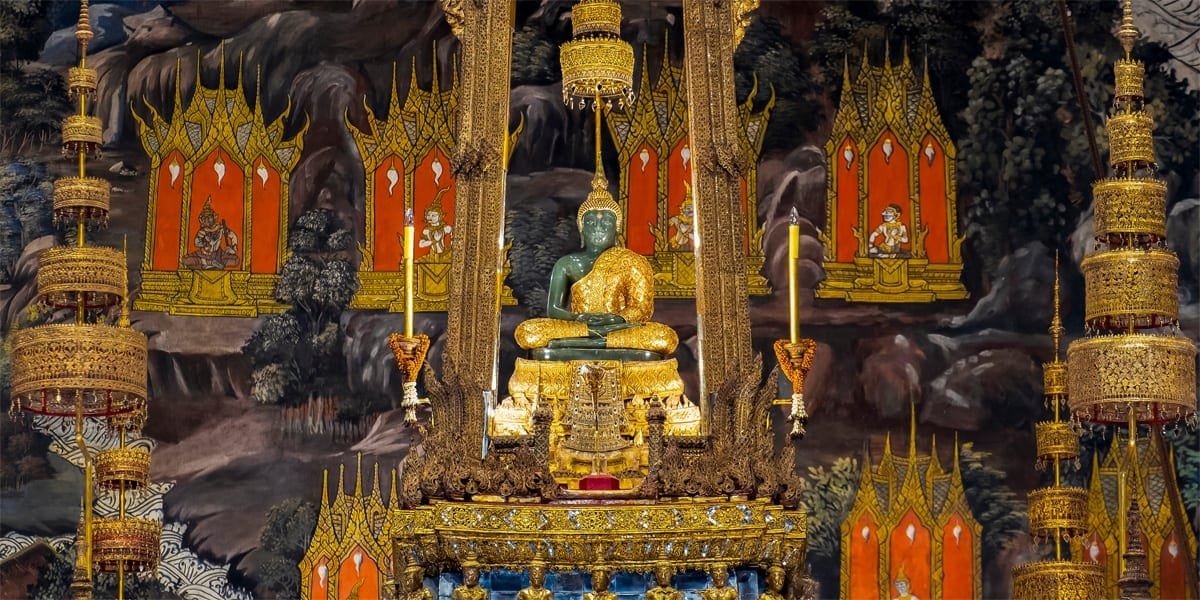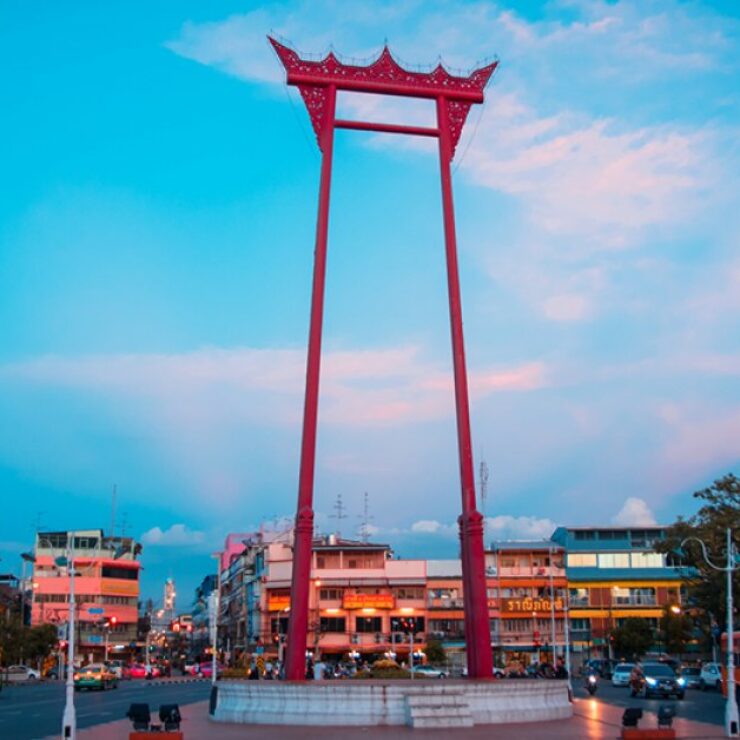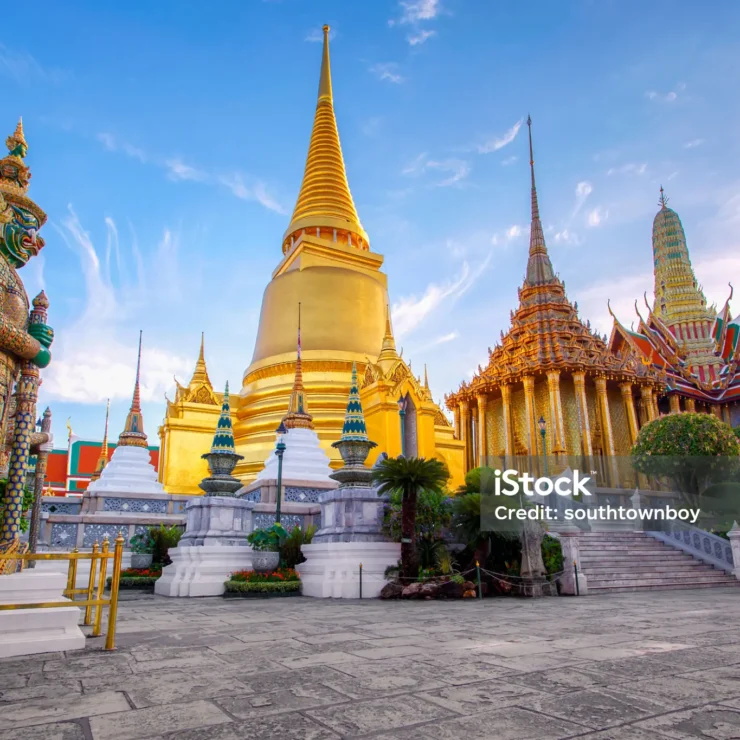Das Kronjuwel der heiligen Landschaft Bangkoks
Eingebettet in das weitläufige Gelände des Großen Palastes von Bangkok befindet sich Wat Phra Kaew, der Tempel des Smaragd-Buddha – Thailands heiligstes buddhistisches Heiligtum und ein Meisterwerk thailändischer religiöser Architektur. Reisende, die das Glück haben, an der Dinso Road zu wohnen, erreichen diesen kulturellen und spirituellen Schatz in nur 15 bis 20 Minuten zu Fuß und erhalten einen Einblick in das Herz des thailändischen Buddhismus und des königlichen Erbes.
Eine heilige Geschichte: Die Reise des Smaragd-Buddha
Die ruhmreiche Geschichte des Tempels reicht bis ins Jahr 1782 zurück, als König Rama I., Gründer der Chakri-Dynastie (Thailands heutige Königsfamilie), die Hauptstadt von Thonburi nach Bangkok verlegte. Der König ordnete den Bau dieses prächtigen Tempels an, um den Smaragd-Buddha zu beherbergen, eine hochverehrte Statue mit einer faszinierenden Geschichte.
Trotz seines Namens ist der Smaragd-Buddha nicht aus Smaragd, sondern aus einem einzigen Stück grünem Jaspis geschnitzt (einige Experten vermuten Nephrit-Jade). Die etwa 66 Zentimeter hohe Statue hat eine geheimnisvolle, sagenumwobene Entstehungsgeschichte. Einer Überlieferung zufolge wurde die Statue 43 v. Chr. in Indien von Nagasena, einem buddhistischen Weisen, geschaffen. Andere Geschichten führen ihre Entstehung auf das alte sri-lankische Königreich Anuradhapura zurück.
Unbestritten ist die bemerkenswerte Reise der Statue durch Südostasien. Historische Aufzeichnungen belegen, dass sie einst in Tempeln in Kambodscha, Laos und Nordthailand untergebracht war, bevor General Chakri (der spätere König Rama I.) sie 1778 nach Bangkok brachte. Diese Reise hat die Mystik und den heiligen Ruf der Buddha-Statue nur noch verstärkt.
Der Tempelkomplex: Eine visuelle Symphonie thailändischer Spiritualität
Wenn Sie sich dem Grand Palace-Komplex von der Dinso Road aus nähern, fallen Ihnen sofort die glänzenden goldenen Türme (Prangs) und die mehrstufigen Dächer des Wat Phra Kaew ins Auge. Im Gegensatz zu den meisten buddhistischen Tempeln Thailands beherbergt Wat Phra Kaew keine Wohnräume für Mönche; sein einziger Zweck ist die Unterbringung und Ehrung des Smaragd-Buddha.
Der Komplex ist von einer dekorativen Galerie mit exquisiten Wandmalereien umgeben, die das komplette Ramakien – Thailands Version des indischen Epos Ramayana – darstellen. Diese 178 Tafeln zählen zu den wertvollsten Kunstschätzen Thailands und veranschaulichen anschaulich den Kampf zwischen Gut und Böse anhand der Abenteuer von Rama, Sita und Hanuman.
Auf dem Hauptgelände des Tempels finden Besucher:
- Der Ubosot (Ordinationssaal): Dieses Gebäude beherbergt den Smaragd-Buddha und stellt den Höhepunkt thailändischer Architektur dar. Der Buddha sitzt auf einem mehrstufigen goldenen Thron, der fast bis zur Decke reicht. Je nach Jahreszeit wechselt der König oder ein königlicher Vertreter dreimal jährlich die Kleidung der Statue, um sie den thailändischen Jahreszeiten anzupassen – heiß, regnerisch und kühl.
- Golden Chedi: Eine glänzende goldene Stupa mit Reliquien des Buddha, deren strahlende Oberfläche das tropische Sonnenlicht einfängt.
- Modell von Angkor Wat: Eine Miniaturnachbildung im Auftrag von König Rama IV., um Thailands historische Verbindung zu Kambodscha zu feiern.
- Phra Mondop: Eine Bibliothek mit heiligen buddhistischen Manuskripten, die auf Palmblättern geschrieben sind.
- Phra Sri Rattana Chedi: Ein goldener Chedi, der ein Stück von Buddhas Brustbein enthält.
- Das Pantheon: Nur an besonderen Tagen (6.-8. April) geöffnet, enthält es Statuen früherer Könige der Chakri-Dynastie.
- Wächterstatuen: Sechs Paare imposanter Yaksha-Wächter (Dämonen) stehen an verschiedenen Eingängen, jeder mit einzigartigen Eigenschaften und mythologischer Bedeutung.
Heilige Präsenz: Der Smaragd-Buddha selbst
Das Herzstück des Tempelkomplexes ist zweifellos die Smaragd-Buddha-Statue. Hoch über den Gläubigen thront der Buddha in der Meditationshaltung des „unterwerfenden Mara“. Trotz ihrer relativ bescheidenen Größe übt die Statue eine überwältigende Präsenz aus, die durch die dramatische Kulisse und die üppigen Dekorationen noch verstärkt wird.
Besucher sollten beachten, dass das Fotografieren des Smaragd-Buddha im Ubosot strengstens verboten ist. Dieses Verbot schützt sowohl die spirituelle Atmosphäre als auch den heiligen Status der Statue. Beobachten Sie im Inneren thailändische Gläubige bei der dreifachen Niederwerfung – sie knien mit zusammengelegten Händen nieder und verbeugen sich dreimal, bis Hände und Stirn den Boden berühren – eine tiefe Geste des Respekts gegenüber Buddha, seinen Lehren und der Klostergemeinschaft.
Kulturelle Bedeutung und königliche Zeremonien
Der Tempel des Smaragd-Buddha ist nicht nur eine Touristenattraktion, sondern ein lebendiges spirituelles Zentrum, das eng mit Thailands Monarchie und nationaler Identität verbunden ist. Der Komplex ist das ganze Jahr über Schauplatz mehrerer bedeutender königlicher Zeremonien:
- Saisonale Robenänderungen: In einer nicht öffentlichen Zeremonie wechselt der König dreimal jährlich das Gewand des Smaragd-Buddha – in den ersten Mondmonaten der heißen Jahreszeit (März-April), der Regenzeit (August) und der kühlen Jahreszeit (November). Dieses uralte Ritual soll dem Land Glück bringen.
- Tag der königlichen Krönung: Jedes Jahr am 4. Mai wird an die Krönung des aktuellen Monarchen erinnert.
- Königliche Pflugzeremonie: Diese Zeremonie findet normalerweise im Mai in Sanam Luang neben dem Großen Palast statt und markiert den Beginn der Reisanbausaison.
- Die Geburtstagsfeierlichkeiten des Königs: Während dieses Nationalfeiertags finden im und um den Tempelkomplex besondere Zeremonien und öffentliche Veranstaltungen statt.
Jedes dieser Ereignisse unterstreicht die zentrale Rolle des Tempels in der kulturellen und spirituellen Landschaft Thailands und repräsentiert die starke Verbindung zwischen Buddhismus, Monarchie und thailändischer Identität.
Praktische Informationen für Besucher
Öffnungszeiten:
- Täglich von 8:30 bis 15:30 Uhr
- Letzter Einlass um 15:30 Uhr (Sie sollten jedoch mindestens 1–2 Stunden für Ihren Besuch einplanen)
- Der Tempel ist gelegentlich für besondere königliche Zeremonien geschlossen
Eintrittspreise:
- 500 Baht für ausländische Besucher (ungefähr $14-15 USD)
- Das Ticket beinhaltet den Eintritt zum Großen Palast, Wat Phra Kaew und dem Königin-Sirikit-Textilmuseum
- Thailändische Staatsbürger haben mit Ausweis freien Eintritt
Strenge Kleiderordnung:
- Männer: Lange Hosen, Hemden mit Ärmeln (keine Tanktops)
- Frauen: Dezente Kleidung, die Schultern und Knie bedeckt (keine durchsichtigen Hemden, eng anliegende Kleidungsstücke oder nackte Schultern)
- Vor dem Betreten der Tempelgebäude müssen die Schuhe ausgezogen werden (nicht jedoch im allgemeinen Komplex).
- Bei Bedarf kann Kleidung in der Nähe des Eingangs gemietet werden (gegen eine geringe Kaution)
Besucheretikette:
- Sprechen Sie leise und verhalten Sie sich respektvoll
- Richten Sie Ihre Füße niemals auf Buddha-Statuen (das gilt in der thailändischen Kultur als äußerst respektlos).
- Fragen Sie um Erlaubnis, bevor Sie Menschen, insbesondere Mönche, fotografieren
- Folgen Sie dem allgemeinen Besucherstrom im Ubosot
- Klettern Sie nicht auf irgendwelche Strukturen, um Fotos zu machen
- Nehmen Sie in Tempelgebäuden Ihre Hüte ab
Spaziergang von der Dinso Road: Ein kultureller Spaziergang
Ein besonderer Vorteil eines Aufenthalts auf der Dinso Road ist der angenehme Spaziergang zum Wat Phra Kaew, der durch historische Viertel Bangkoks führt. Die etwa 1,5 Kilometer lange Strecke (ca. 15–20 Minuten) verläuft wie folgt:
- Von der Dinso Road aus fahren Sie Richtung Osten in Richtung Democracy Monument
- Fahren Sie weiter in Richtung Ratchadamnoen Avenue
- Folgen Sie der Ratchadamnoen Klang Road vorbei an den historischen Gebäuden und Denkmälern
- Biegen Sie rechts auf die Na Phra Lan Road ab
- Der Eingang zum Großen Palast ist auf der linken Seite sichtbar.
Auf dieser Route kommen Sie an mehreren bemerkenswerten Sehenswürdigkeiten vorbei:
- Demokratiedenkmal
- Rattanakosin-Ausstellungshalle
- Das Verteidigungsministerium
- Sanam Luang (Königliches Feld)
- Das Nationalmuseum
- Thammasat-Universität
Besonders angenehm sind Spaziergänge am frühen Morgen (vor 8:00 Uhr), bei denen Sie den Menschenmassen und der Mittagshitze aus dem Weg gehen und gleichzeitig miterleben können, wie Bangkok in einen neuen Tag erwacht.
Beste Reisezeiten und Insidertipps
Optimale Besuchszeiten:
- Kommen Sie früh (8:30-9:00 Uhr), um Menschenmassen und Hitze zu entgehen
- An Wochentagen ist im Allgemeinen weniger los als am Wochenende
- Vermeiden Sie einen Besuch während wichtiger Feiertage wie Songkran (thailändisches Neujahr) oder chinesisches Neujahr, da dann die Zahl der Touristen stark ansteigt.
- In den Morgenstunden ist das Licht zum Fotografieren oft am besten
Führungen:
- Offizielle Führer mit Ausweisen stehen am Eingang zur Verfügung (800-1.000 Baht für eine 2-stündige Tour)
- Audioguides können für 200 Baht gegen Hinterlegung einer ID-Kaution gemietet werden
- Kostenlose Führungen auf Englisch beginnen manchmal um 10:00 Uhr und 14:00 Uhr (erkundigen Sie sich am Informationsschalter).
Wichtige Tipps:
- Nehmen Sie Wasser mit (außerhalb des Komplexes verkaufen Händler jedoch Getränke).
- Tragen Sie bequeme Slipper, da Sie diese häufig ausziehen werden
- Bringen Sie einen Hut und Sonnencreme mit – ein Großteil des Komplexes ist nicht überdacht
- Erwägen Sie die Beauftragung eines Fremdenführers, um tiefere kulturelle Einblicke zu erhalten
- Planen Sie mindestens 2-3 Stunden für Ihren Besuch ein
- Es gibt saubere Toiletten in der Nähe des Ticketschalters und am Ausgang
- Kostenlose Wasserstationen stehen innerhalb des Komplexes zur Verfügung
Jenseits des Tempels: Sehenswürdigkeiten in der Nähe
Nachdem Sie Wat Phra Kaew erkundet haben, verdienen mehrere bedeutende Sehenswürdigkeiten, die zu Fuß erreichbar sind, Ihre Aufmerksamkeit:
- Der Große Palast: Diese ehemalige königliche Residenz ist bereits in Ihrem Ticket inbegriffen und zeigt atemberaubende thailändische Architektur und beherbergt mehrere Museen.
- Wat Pho (Tempel des liegenden Buddha): Nur 10 Gehminuten südlich gelegen, beherbergt dieser Tempel den riesigen 46 Meter langen liegenden Buddha und Thailands führende Massageschule.
- Museum von Siam: Ein modernes, interaktives Museum, das die kulturelle Entwicklung und Identität Thailands erklärt.
- Pak Khlong Talat (Blumenmarkt): Bangkoks lebhafter 24-Stunden-Blumenmarkt bietet ein farbenfrohes Sinneserlebnis.
- Sanam Luang: Auf diesem königlichen Feld finden wichtige Zeremonien statt und es dient als öffentlicher Erholungsort.
- Amulettmarkt: Stöbern Sie entlang der Maharat Road durch Tausende buddhistischer Amulette und Talismane.
- Khaosan Straße: Obwohl touristisch, ist dieses berühmte Backpacker-Paradies für alle, die neugierig auf die lebhafte Atmosphäre sind, nur 15 Gehminuten nördlich gelegen.
Saisonale Überlegungen und Kulturkalender
Der Tempel des Smaragd-Buddha bewahrt seine Pracht das ganze Jahr über, aber saisonale Faktoren können Ihren Besuch beeinflussen:
- November bis Februar (Kühle Jahreszeit): Die angenehmste Zeit für einen Besuch mit niedrigerer Luftfeuchtigkeit und niedrigeren Temperaturen. Der Smaragd-Buddha trägt sein wintergoldenes Gewand.
- März bis Mai (heiße Jahreszeit): Sehr heiß, aber mit lebhaften Feierlichkeiten zu Songkran im April. Der Buddha trägt während dieser Zeit eine Krone und Schmuck.
- Juni bis Oktober (Regenzeit): Kurze, aber intensive Regenschauer am Nachmittag mit weniger Touristen. Der Buddha ist mit einem vergoldeten Monsungewand geschmückt.
Zu den besonderen Ereignissen im Laufe des Jahres zählen das chinesische Neujahrsfest (Januar/Februar), Songkran (13.–15. April), die königliche Pflugzeremonie (Mai) und die Feierlichkeiten zum Geburtstag des Königs (28. Juli).
Spirituelle Bedeutung: Die tiefere Bedeutung verstehen
Um Ihren Besuch wirklich wertzuschätzen, sollten Sie die tiefe spirituelle Bedeutung dieses Tempels für die Thailänder bedenken. Der Smaragd-Buddha gilt als Palladium des thailändischen Königreichs – ein Schutzsymbol, das den Wohlstand der Nation sichert. Viele Thailänder glauben, dass die thailändische Nation bestehen wird, solange der Smaragd-Buddha in Bangkok bleibt.
Im Buddhismus stellt die Statue nicht nur den historischen Buddha dar, sondern verkörpert auch die Konzepte von Weisheit, Mitgefühl und Erleuchtung. Die kunstvollen Verzierungen – von filigranen Schnitzereien bis hin zu Blattgoldornamenten – dienen nicht nur der Ästhetik, sondern sind Ausdruck von Hingabe und Ehrfurcht.
Wenn Sie zwischen thailändischen Gläubigen wandeln, achten Sie auf ihre tiefe Ehrfurcht – das sorgfältige Ausziehen der Schuhe, die tiefen Niederwerfungen, das Darbringen von Lotusblumen und Weihrauch. Dies sind Einblicke in eine spirituelle Tradition, die die thailändische Kultur seit Jahrhunderten prägt.
Ein lebendiges Erbe in fußläufiger Entfernung
Der Tempel des Smaragd-Buddha ist ein nationales Kulturgut und zugleich ein Fenster zum spirituellen Herzen Thailands. Seine Erreichbarkeit von der Dinso Road macht ihn nicht nur zu einer Sehenswürdigkeit, die man gesehen haben muss, sondern zu einem Ort, den Sie während Ihres Aufenthalts immer wieder besuchen können. Vielleicht erleben Sie ihn in unterschiedlichem Licht, zu unterschiedlichen Zeiten und mit einer immer fundierteren Perspektive.
Ob Sie von der exquisiten Architektur, der faszinierenden Geschichte, der spirituellen Atmosphäre oder einfach nur von der Möglichkeit, Thailands heiligste Buddhastatue zu sehen, fasziniert sind – Wat Phra Kaew bietet eine unvergessliche Begegnung mit der thailändischen Kultur. Der kurze Spaziergang von Ihrer Unterkunft an der Dinso Road verwandelt einen typischen Sightseeing-Ausflug in eine bedeutungsvolle Pilgerreise durch das lebendige Erbe der spirituellen und monarchischen Traditionen Thailands.
Wenn Sie durch die reich verzierten Tore gehen, nehmen Sie nicht nur Fotos und Erinnerungen mit, sondern auch eine tiefere Wertschätzung für die kulturellen Kräfte, die das Land des Lächelns seit Jahrhunderten geprägt haben – und das alles nur einen angenehmen Morgenspaziergang von Ihrer Haustür entfernt.




